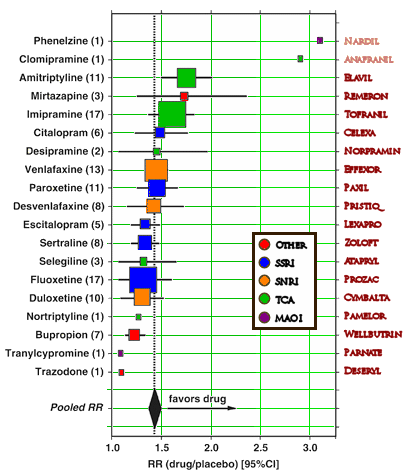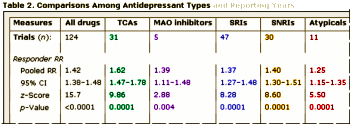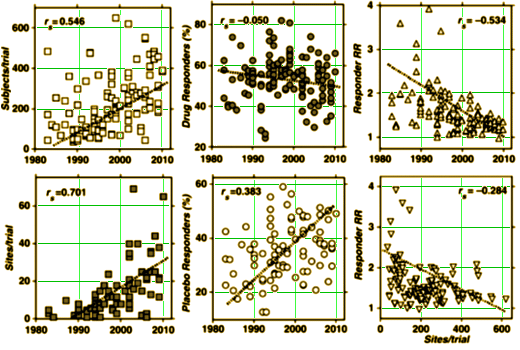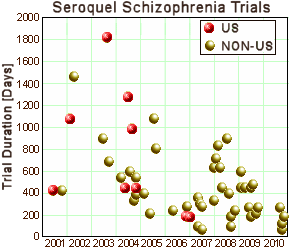Randomized, Placebo-Controlled Trials of Antidepressants for Acute Major Depression: Thirty-Year Meta-Analytic Review
by Juan Undurraga and Ross J Baldessarini
Neuropsychopharmacology [advance online publication]
14 December 2011
Abstract: Antidepressant–placebo response-differences [RDs] in controlled trials have been declining, potentially confounding comparisons among older and newer drugs. For clinically employed antidepressants, we carried out a meta-analytic review of placebo-controlled trials in acute, unipolar, major depressive episodes reported over the past three decades to compare efficacy [drug–placebo RDs] of individual antidepressants and classes, and to consider factors associated with year-of-reporting by bivariate and multivariate regression modeling. Observed drug–placebo differences were moderate and generally similar among specific drugs, but larger among older antidepressants, notably tricyclics, than most newer agents. This outcome parallels selective increases in placebo-associated responses as trial-size has increased in recent years. Study findings generally support moderate efficacy of clinically employed antidepressants for acute major depression, but underscore limitations of meta-analyses of controlled trials for ranking drugs by efficacy. We suggest that efficiency and drug–placebo differences may be improved with fewer sites and subjects, and better quality-control of diagnostic and clinical assessments.
This has been an odd era – one in which Clinical Drug Trials have reigned supreme. Undurraga and Baldessarini did a meta-analysis of the antidepressant drug trials for the last thirty years, ending up with only 116 candidates from over 2000 studies that met their criteria [placebo controlled, randomized, double blind trials]. The used the study RR [Response Rate] for comparison [if X = mean % fall in rating scale then Xdrug ÷ Xplacebo = RR].

| With apologies, I have altered this table from the study by adding the more familiar Brand Names on the right, removing the numeric values, and color-coding in the drug classes. They considered the Nardil and Anafranel values outliers [to be ignored]. The box size is proportional to the number of studies. The line is the 95% Confidence Interval. |
Without considering other factors, the results are ironic – the first two drugs [introduced 50 years ago], Tofranil and Elavil, are the most efficacious:

But this paper went further [to the authors’ credit]. They looked at the year the study was done, and the values of Xdrug and Xplacebo over the years [center two graphs]:

As you can see, in these Clinical Trials, there’s no change trend in the drug responders [Drug Responders (%)], but there’s a dramatic change trend in the placebo responders [Placebo Responders (%)]. There is an equally impressive increase in subjects and sites per study over the years [left-most graphs].
The authors conclude "We suggest that efficiency and drug–placebo differences may be improved with fewer sites and subjects, and better quality-control of diagnostic and clinical assessments" [see the graphs on the far right]. Surely that’s correct – particularly "better quality-control of diagnostic and clinical assessments." The escalating number of subjects and sites is, in part, an attempt to compensate for the epidemic of placebo responders. They also conclude that "Study findings generally support moderate efficacy of clinically employed antidepressants for acute major depression, but underscore limitations of meta-analyses of controlled trials for ranking drugs by efficacy" which also seems intuitively true.
These thoughts below the line are mine, not from these authors. People talk about the problem of the increasing placebo effect over the years as if it’s a great mystery. I don’t see it as any mystery at all. It parallels the rise of the Clinical Research Industry with Clinical Research Organizations and Clinical Research Centers scattered far and wide over the globe. These aren’t the clinically depressed patients that come to our offices. They’re another breed – a heterogeneous collage of people recruited from who-knows-where to be in a study. In spite of the fact that they seem to be trying to hide the source of patients, it doesn’t take long to recognize that these are hardly the DSM-IV MDD patients advertised – rather ad responders, students, pros, characterologic patients, the curious, etc. While I’m sympathetic with the problem of finding subjects, the way it’s being done makes the studies suspect right out of the gate. That’s my view of the "placebo effect" changes.
One thing this study leaves out is the other reason for so many sites. The Clinical Research Organizations advertise a rapid time-to-market. One way to do that is to call on multiple sites to come up with a few cases each. I haven’t seen any publications that study that part. I tried to look at it myself. I don’t have access to enough data to do anything definitive. But I did look at the Seroquel trials on clinicaltrials.gov over the years. They shortened the study duration by ‘globalization’:

My guess is that this trend would be reflected in other studies as well both by ‘globalization’ and increasing the number of sites [but it’s not for some blogger on a mountain in Georgia to prove]. My point is only that all of this weirdness in Clinical Trial data is hardly supernatural. It’s obviously because the Clinical Trials are being done in a weird way that’s focused specifically on getting statistical significance rapidly on the way to market rather that a heartfelt attempt at measuring efficacy, toxicity, and robustness.
As a clinician, I spent much of the last 25 years actually thinking that the SSRIs were both more efficacious and less toxic than the TCAs that preceded them. I didn’t believe that because I was a biological psychiatrist caught up in the whirlwind of the psychopharmacological revolution. It was just part of the general lore of the specialty. Both of those things were, in fact, wrong. I steered clear of certain of the SSRI/SNRI drugs because of withdrawal syndromes, but I didn’t learn about those things from the literature. I was made aware by seeing patients who’d had bad experiences. As a practicing psychiatrist, the things I’d relied on in the past to keep me up to speed on drugs, old and new, misinformed me. The intuition I had for what was science and what was advertisement no longer functioned as it had earlier in my career. In former days, I could count on Clinical Trials in peer-reviewed journals being performed on patients with the disorders listed in the article. I could no longer count on that being true. I could count on academic experts. Not any more. There was no solid ground. I would have been better off prescribing exactly as I had in 1977 when I finished my residency – TCA antidepressants, first generation antipsychotics, Lithium Carbonate, and Benzodiazepines [for anxiety that had to be treated].
It was about making money, like a lemonade stand with simple offerings turns into corporate big house coffee chain with bells and whistles, leaving ppl after the rush and excitement to wanting the old days again… more is not better…
I am so sorry, Mickey. You deserved better, much better. This may not be a good metaphor, but it seems like you might have been an electrician who was given plumbing tools. You deserved, as did your patients, a more robust arsenal. And to me the saddest thing is the ground that was LOST because so many thought we had it right.
What was that all about? It was about the illusion of ramping up clinical research to an industrial scale. The smoke and mirrors game required several key components: it was about dumbing down of diagnoses through checklists; it was about dumbing down of clinical assessments through structured interviews; it was about a belief that efficiency could be achieved through recruiting symptomatic volunteers rather than real patients who arrived via the inefficient clinical referral process; it was about imputing validity to on-line and telephone assessments; it was about a belief that brute force of numbers would overcome the crippling heterogeneity of enrolled subjects; it was about treating patients as commodities whose opinions on efficacy were disregarded; and it was about disease mongering with the goal of maximizing the market. Oh, and it was also about money – for the corporations and for the opportunistic helper academics and of course for the satellite industry of CROs and the like that sprang up. Along the way, the really incisive clinical research questions were studiously avoided. That is the dismal record of academic psychiatry over the past 30 years. These new data confirm the futility of those strategic blunders.
Thank you, thank you, thank you Mickey and Bernard Carroll! Very grateful for your honesty and analysis of a very ugly situation.
Mickey, I feel entirely betrayed as well. I entered med school in the 90s, residency in the early 00’s, all the while charmed and dazzled by the promises of neuropharmacology. And because I learned from teachers with such impressive credentials, who was I to challenge them? It was as if they had figured out the precise pathways and mechanisms underlying all of mental illness, and there were legions of patients awaiting me, eager to access my neurobiological knowledge, my compassionate ear, and my prescription pad.
I now realize (thanks to your writings, and, of course, simple observation as a clinician– as you know, it does not take a rocket scientist) that I was misled. Perhaps not consciously so– at least by my teachers– but misled nonetheless. It pains me to think of the years of education I have wasted on the “smoke and mirrors,” as Dr Carroll correctly calls it.
It pains me even more to think that I have to take my ABPN Board exams in May and force myself to re-learn and regurgitate this pseudoscience in order to become a “real” psychiatrist.
A most wonderful comment, Steve!
It has occurred to me that good psychiatrists such as yourself, David Allen, Joel Hassman (and of course Mickey!) must all feel betrayed. And obviously, patients feel betrayed. I should know. I was put on Paxil at age 14 almost 15 years ago for what was in hindsight perfectly understandable situational anxiety. I was one of those patients you mentioned in a recent post on your blog that really never should have been a psych patient at all. And the reason I’m still on an SSRI (now Lexapro) 15 years later is because the withdrawals kicked my ass when I tried to get off the meds, and no doctor knew how to withdraw me a decade ago. I’m withdrawing now and will hopefully be off Lexapro in March (hooray!), but only because of a tapering schedule I learned about ON A MESSAGE BOARD, not from any psychiatrist. I don’t have to tell you that’s beyond pathetic.
I honestly think psychiatry is but just a microcosmal example of a larger disease in this country: the hollowing out of real professions (or the outright destruction of them, like the manufacturing sector) for the almighty dollar, and then loading up both the general public and those in the professions with solid smoke to fool them into thinking they have it better than they do.
Your dose of solid smoke was, as you so beautifully describe, all the neuropsychopharmacology baloney you were doled out in school. All it really boils down to is a way for “the big club” (in this case, the APA and the NIMH) to continue lining their pockets and CVs. As a student of history, I’m amazed that nothing really changes. The APA/NIMH and the KOLs really are the new kings and queens and whereas these kings and queens may not commit obtuse acts of brutality (beheadings, imprisonment, torture, etc), they have simply misused their intelligence to refine their malice in a most sophisticated way by tampering with science and the media. It’s still an abuse of power any way you slice it, and the human misery and suffering is just as real as any in history.
So here we are. All of a sudden all of us involved in psychiatry (whether the psychiatrists themselves or the patients) have realized that once you remove all the corruption and bad science of the last three decades, we’re largely right back to where we were in the early ’80s right before the DSM III came out and started the biomedical model revolution. As Mickey brilliantly pointed out in his psychiatric-industrial complex post, psychiatry has become essentially a three-ring con game between the NIMH/APA, the FDA, and pharma companies which enables psychiatry to experiment on the brains of the public with little to no regard for safety or science, and much regard for profit. This is what it looks like, folks.
And I’m sure you know I’m no conspiracy theorist.
Or might it be that the smaller studies are naturally prone to more randomness and variation, and with any negative studies going unpublished, there is a misleadingly high effect size.
Squamous, that’s a hypothetical argument often put forward, but that speculation will not explain the more than doubling of response rates to placebo over 30 years. For that, loss of quality control in patient recruitment while pursuing high volume enrolment in a hurry is the default explanation.